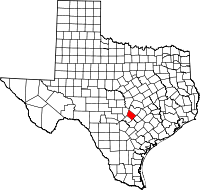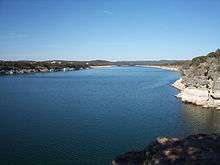Hays County, Texas
| Hays County, Texas | |
|---|---|
|
Hays County Courthouse, built in 1908 using the eclectic style of architecture | |
 Location in the U.S. state of Texas | |
 Texas's location in the U.S. | |
| Founded | 1848 |
| Named for | John Coffee Hays |
| Seat | San Marcos |
| Largest city | San Marcos |
| Area | |
| • Total | 680 sq mi (1,761 km2) |
| • Land | 678 sq mi (1,756 km2) |
| • Water | 1.9 sq mi (5 km2), 0.3% |
| Population | |
| • (2010) | 157,107 |
| • Density | 232/sq mi (90/km²) |
| Congressional districts | 21st, 25th, 35th |
| Time zone | Central: UTC-6/-5 |
| Website |
www |
Hays County is a county located on the Edwards Plateau in the U.S. state of Texas. As of the 2010 census, its official population had reached 157,107.[1] The county seat is San Marcos.[2] The county is named for John Coffee Hays, a Texas Ranger and Mexican–American War officer.
Hays County is part of the Austin-Round Rock, TX Metropolitan Statistical Area.
History
- 6000 BC Paleo-Indians were the first inhabitants.[3]
- Archeological evidence at Timmeron site indicated the Tonkawa tribe was involved in agriculture around 1200 AD.[3]
- Father Isidro Félix de Espinosa, Father Antonio de San Buenaventura y Olivares, and Pedro de Aguirre were in an expedition in the area in 1709.[4]
- French-Canadian explorer Louis Juchereau de St. Denis was attacked by Comanches in 1714.[5]
- In 1755, Mission San Francisco Xavier de los Dolores was established among the Apache tribe.[6]
- In 1831, Coahuila y Tejas[7] issued a land grant to Juan Martín de Veramendi,[8] to Juan Vicente Campos in 1832,[3] and to Thomas Jefferson Chambers in 1834.[3]
- The Mexican government issued a land grant to the first Anglo-American settler in the county, Thomas G. McGhee of Tennessee in 1835.[3]
- On March 1, 1848, the legislature formed Hays County from Travis County. The county is named for Tennessee transplant Captain John Coffee Hays[9] of the Texas Rangers. San Marcos was named as the county seat.[10]
- The legislature established Blanco from part of Hays in 1858, but incorporated part of Comal into Hays. Risher and Hall Stage Lines controls 16 of 31 passenger and mail lines in Texas.[3]
- In 1861, voters in the county favored secession from the Union.[3]
- The legislature transferred more of Comal County to Hays County in 1862.[3]
- In 1867, the first cattle drive from Hays County to Kansas occurred.[3]
- International-Great Northern Railroad was completed from Austin to San Marcos in 1880.[3]
- Camp Ben McCulloch, named after a brigadier general, was organized in 1896 for reunions of United Confederate Veterans.[11]
- A teacher’s college, Southwest Texas State Normal School, was established in San Marcos in 1899.[12]
- Wonder Cave opened to the public in 1900.[13]
- The current Hays County Courthouse in San Marcos was erected in 1908. Beaux-Arts style by Architect C.H. Page & Bros.[14]
- The Aquarena Springs tourist site opened in 1928 in San Marcos.[15]
- Lyndon Baines Johnson graduated from Southwest Texas State Teachers College in 1930.[16]
- In 1942, construction of San Marcos Army Air Field began.[17]
- San Marcos Army Air Field was renamed Gary Air Force Base in 1953 to honor Second Lieutenant Arthur Edward Gary, the first San Marcos resident killed in World War II.[17]
- The state legislature resurveyed the Hays and Travis County lines, adding 16,000 acres (65 km2) to Hays County in 1955.[3]
- In 1964, U.S. President Lyndon Johnson announced the establishment of a Job Corps center based at the deactivated Gary Air Force Base.[18]
Geography
According to the U.S. Census Bureau, the county has a total area of 680 square miles (1,800 km2), of which 678 square miles (1,760 km2) are land and 1.9 square miles (4.9 km2) (0.3%) are covered by water.[19]
Major highways
Adjacent counties
- Travis County (northeast)
- Caldwell County (southeast)
- Guadalupe County (south)
- Comal County (southwest)
- Blanco County (northwest)
Demographics
| Historical population | |||
|---|---|---|---|
| Census | Pop. | %± | |
| 1850 | 387 | — | |
| 1860 | 2,126 | 449.4% | |
| 1870 | 4,088 | 92.3% | |
| 1880 | 7,555 | 84.8% | |
| 1890 | 11,352 | 50.3% | |
| 1900 | 14,142 | 24.6% | |
| 1910 | 15,518 | 9.7% | |
| 1920 | 15,920 | 2.6% | |
| 1930 | 14,915 | −6.3% | |
| 1940 | 15,349 | 2.9% | |
| 1950 | 17,840 | 16.2% | |
| 1960 | 19,934 | 11.7% | |
| 1970 | 27,642 | 38.7% | |
| 1980 | 40,594 | 46.9% | |
| 1990 | 65,614 | 61.6% | |
| 2000 | 97,589 | 48.7% | |
| 2010 | 157,127 | 61.0% | |
| Est. 2015 | 194,739 | [20] | 23.9% |
| U.S. Decennial Census[21] 1850–2010[22] 2010–2014[1] | |||
As of the census[23] of 2000, 97,589 people, 51,265 households, and 22,150 families resided in the county. The population density was 144 people per square mile (56/km²). The 55,643 housing units averaged 53 per mi2 (20/km2). The racial makeup of the county was 78.92% White, 3.68% Black or African American, 0.69%Native American, 0.79% Asian, 0.07% Pacific Islander, 13.36% from other races, and 2.49% from two or more races. About 29.57% of the population were Hispanic or Latino of any race.
Of the 33,410 households, 34.00% had children under the age of 18 living with them, 53.10% were married couples living together, 9.00% had a female householder with no husband present, and 33.70% were not families; 21.00% of all households were made up of individuals and 4.90% had someone living alone who was 65 years of age or older. The average household size was 2.69 and the average family size was 3.21.
A Williams Institute analysis of 2010 census data found there were about 7.4 same-sex couples per 1,000 households in the county.[24]
In the county, the population was distributed as 24.50% under the age of 18, 20.50% from 18 to 24, 28.20% from 25 to 44, 19.10% from 45 to 64, and 7.70% who were 65 years of age or older. The median age was 28 years. For every 100 females, there were 101.30 males. For every 100 females age 18 and over, there were 99.50 males.
The median income for a household in the county was $45,006, and for a family was $56,287. Males had a median income of $35,209 versus $27,334 for females. The per capita income for the county was $19,931. About 6.40% of families and 14.30% of the population were below the poverty line, including 10.30% of those under age 18 and 9.70% of those age 65 or over.
Education
School districts in Hays county include the San Marcos Consolidated, Dripping Springs Independent, Wimberley Independent, and Hays Consolidated schools. As of 2009, three high schools, five middle schools, and 11 elementary schools are in the county.
Higher education in Hays County includes one four-year institution, Texas State University, in San Marcos. Three Distance Learning Centers are operated by Austin Community College. These centers offer basic and Early College Start classes, along with testing centers for online classes.
Politics
Like the rest of Texas, Hays County was once a strongly Democratic Party leaning county in federal elections, even by Solid South standards. However, like other rural and suburban counties in the state, the county has been leaning towards the Republican Party. The last Democrat to carry Hays County in a presidential election was Bill Clinton with a plurality of 39.8% of the vote in 1992. The last Democrat to win a majority of the vote in the county was Jimmy Carter with 54.4% in 1976. Lloyd Bentsen is the last Democratic senatorial candidate to carry the county, winning 69.2% of the vote in 1988.[25]
The county is no less Republican at the state level. Ann Richards is the most recent Democratic gubernatorial candidate to win the county, having done so in 1990 with 56.6% of the vote.[26]
Democratic strength lies primarily in the city of San Marcos due to the presence of Texas State University. Republican strength lies within the more rural cities of Buda, Kyle, and Wimberley.
Communities
Cities (multiple counties)
- Austin (primarily in Travis County)[27]
- Niederwald (partly in Caldwell County)
- San Marcos (county seat) (small parts in Caldwell and Guadelaupe counties)
- Uhland (partly in Caldwell County)
Cities
Village
Census-designated place
Gallery
See also
- List of museums in Central Texas
- National Register of Historic Places listings in Hays County, Texas
References
- 1 2 "State & County QuickFacts". United States Census Bureau. Retrieved December 17, 2013.
- ↑ "Find a County". National Association of Counties. Retrieved 2011-06-07.
- 1 2 3 4 5 6 7 8 9 10 11 Cecil, Paul F; Greene, Daniel P. "Hays County, Texas". Handbook of Texas Online. Texas State Historical Association. Retrieved 1 December 2010.
- ↑ Foster, William C (1995). Spanish Expeditions into Texas, 1689-1768. University of Texas Press. p. 117. ISBN 978-0-292-72489-1.
- ↑ Weddle, Robert S (1991). The French Thorn: Rival Explorers in the Spanish Sea, 1682-1762. TAMU Press. p. 200. ISBN 978-0-89096-480-4.
- ↑ Arias, David (2009). The First Catholics of the United States. lulu.com. pp. 180–181. ISBN 978-0-557-07527-0.
- ↑ "Coahuila and Tejas". Handbook of Texas Online. Texas State Historical Association. Retrieved 1 December 2010.
- ↑ "Juan Martín de Veramendi". Handbook of Texas Online. Texas State Historical Association. Retrieved 1 December 2010.
- ↑ Gannett, Henry (1905). The Origin of Certain Place Names in the United States. Govt. Print. Off. p. 153.
- ↑ "San Marcos, Texas". Texas Escapes. Texas Escapes - Blueprints For Travel, LLC. Retrieved 1 December 2010.
- ↑ Winfrey, Dorman. "Camp Ben Mcculloch". Handbook of Texas Online. Texas State Historical Association. Retrieved 1 December 2010.
- ↑ "San Marcos Campus". Texas State University. Retrieved 1 December 2010.
- ↑ "Wonder World Park". Retrieved 1 December 2010.
- ↑ "Hays County Courthouse". Texas Escapes. Texas Escapes - Blueprints For Travel, LLC. Retrieved 1 December 2010.
- ↑ "Aquarena Springs". Texas State University. Retrieved 1 December 2010.
- ↑ Pietrusza, David (2008). 1960--LBJ vs. JFK vs. Nixon: The Epic Campaign That Forged Three Presidencies. Union Square Press. p. 20. ISBN 978-1-4027-6114-0.
- 1 2 Ratisseau, Shirley. "Gary Air Force Base". Handbook of Texas Online. Texas State Historical Association. Retrieved 1 December 2010.
- ↑ "Gary Job Corps Center". Handbook of Texas Online. Texas State Historical Association. Retrieved 1 December 2010.
- ↑ "2010 Census Gazetteer Files". United States Census Bureau. August 22, 2012. Retrieved April 28, 2015.
- ↑ "County Totals Dataset: Population, Population Change and Estimated Components of Population Change: April 1, 2010 to July 1, 2015". Retrieved July 2, 2016.
- ↑ "U.S. Decennial Census". United States Census Bureau. Retrieved April 28, 2015.
- ↑ "Texas Almanac: Population History of Counties from 1850–2010" (PDF). Texas Almanac. Retrieved April 28, 2015.
- ↑ "American FactFinder". United States Census Bureau. Retrieved 2011-05-14.
- ↑ Where Same-Sex Couples Live, June 26, 2015, retrieved July 6, 2015
- ↑ http://uselectionatlas.org/RESULTS/
- ↑ http://uselectionatlas.org/RESULTS/
- ↑ "City of Austin Full Purpose Jurisdiction" (PDF). City of Austin. 2006-03-09. Retrieved 2010-05-01.
Further reading
- DeCook, K.J. (1963). Geology and ground-water resources of Hays County, Texas [U.S. Geological Survey Water-Supply Paper 1612]. Washington, D.C.: U.S. Government Printing Office.
External links
- Hays County government's website
- Hays County from the Handbook of Texas Online
- HaysWeb - Hays County Information
- Hays County Historical Commission
 |
Blanco County | Travis County |  | |
| |
||||
| ||||
| | ||||
| Comal County | Guadalupe County | Caldwell County |
Coordinates: 30°04′N 98°02′W / 30.06°N 98.03°W





